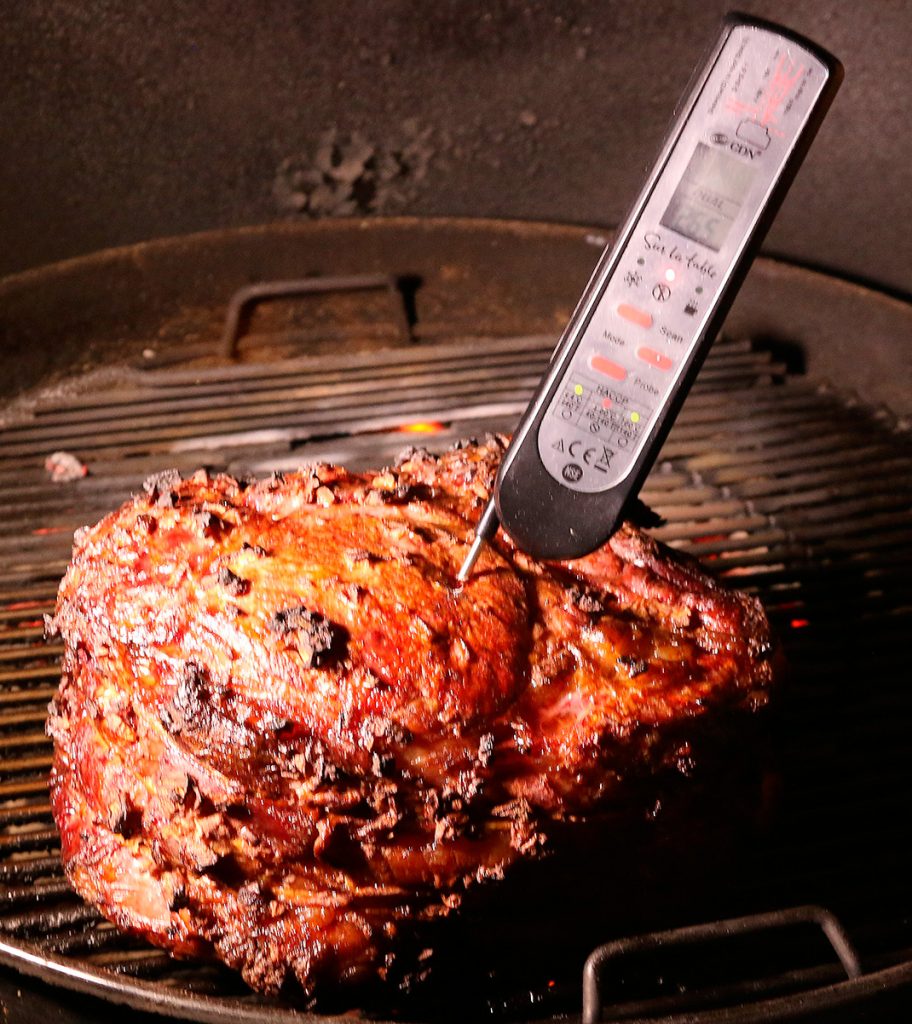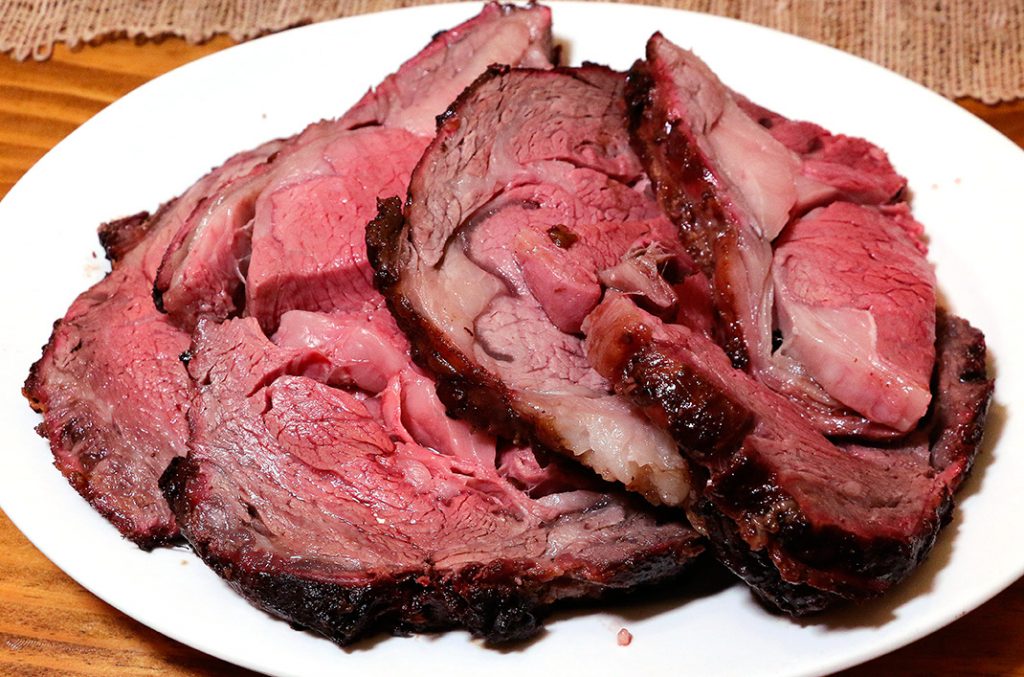
A finished prime rib roast sits on the grill. (Photo ©Chris Wilkins/Texas BBQ Posse)
For me, nothing compares to cooking a prime rib roast on the grill. It’s a tasty cut of meat, always fun to prepare, and sometimes there can be a bit of adventure.
And let’s not forget the cost. For this cook, we special ordered a four-bone, seven-pound rib roast from our neighborhood H-E-B in Austin, Tx. Price: About $85. Not a fortune, but certainly enough to keep the mind focused on proper preparation and technique, even after a glass or two of wine on a sunny autumn afternoon.
The first time I cooked a rib roast was four decades ago while on vacation at Keuka Lake in Upstate New York. Still a rookie griller, I followed the instructions carefully. The meat looked wonderful as I pulled it off the Weber and moved it, covered by foil, to a nearby picnic table.
You gotta let the meat rest, right?

A rubbed rib roast is placed on the grill. (Photo ©Chris Wilkins/Texas BBQ Posse)
Of course, as I tidied up and momentarily turned my back, Bo, our very friendly Irish Setter-Golden Retriever mix, helped himself. Undeterred, we shooed him away, recovered the roast he had dragged to the ground, cleaned it up, and carved out his bite marks. For dinner, we still served prime rib to our guests, along with a good story of canine drama. Everyone loved the food . . .and the story.
Another time, in the late 1980s at our home in Dallas, I cooked a big rib roast on a gas grill. Yes, I confess, on occasion in my grilling-barbecue career, I have used gas. Please don’t hold it against me.
Everything seemed fine at the beginning of the cook. I had shut down half the burners, replicating I thought, the two-zone method on a Weber. But when I made my first check a half-hour or so in, big flames were shooting everywhere from the grill. We were lucky the neighbors didn’t call the fire department. Even worse, for a while I thought that the roast was ruined.
I was able to get it off the grill and back into the kitchen while I tempered the flames and adjusted the vents. I put the roast back on and now kept very close watch on the fire. In the end, despite the conflagration, the rib roast turned out great, with a nice sear on the surface and medium rare beef inside, just like it was planned.
Maybe because of more experience and grilling maturity, my most recent rib roast cook in Austin involved little drama. I used my go-to recipe from Weber’s Way to Grill and also made a sauce for the meat with wine and drippings. The side dishes were made by Sherry Jacobson (twice-baked potatoes), Mike Gagne (collard greens with bacon) and Libby Gagne (kale salad).
Afterwards, Posse co-founder Chris Wilkins, who joined us from Dallas, said it was the best meal he has eaten all year. Chris might be a little biased, but we’ll take the compliment.

Ingredients used in preparing the rub for a prime rib roast. (Photo ©Chris Wilkins/Texas BBQ Posse)
Gary’s favorite rib roast recipe
Ingredients
1 rib roast (7 pounds, bone in) trimmed of excess fat
Kosher salt
Freshly ground pepper
1/4 cup Dijon mustard
1/3 cup coarsely ground yellow onion
4 garlic cloves, finely chopped
Hickory, apple and/or pecan wood chips
Sauce
3 tablespoons unsalted butter, cold, divided
3 tablespoons finely chopped shallot
2 garlic cloves, finely chopped
4 cups beef stock
1 1/2 cups cabernet sauvignon
1 tablespoon soy sauce
1 1/2 teaspoons tomato paste
1/4 teaspoon dried thyme
1 bay leaf
Cooking the rib roast
Salt (a couple teaspoons) and pepper (a teaspoon or so) the roast. Mix the mustard, onion and garlic and rub on the roast. Let stand for a half-hour or so.

A probe thermometer is used to check the internal temperature of the rib roast. (Photo ©Chris Wilkins/Texas BBQ Posse)
Set up your Weber for two-zone, indirect cooking. Start with a chimney and a half or so of charcoal. Cook time could total a couple hours for medium rare. Keep the covered grill temperature at 350-375 degrees. Add some wood chips to the fire, but don’t overdo it. A little smoke goes a long way on rib roast. Also, add a few briquets halfway through, if necessary.
For a boneless roast, Weber suggests rotating the meat 180 degrees midway through the cook. With the bone still in, I didn’t rotate. I kept the bone side facing the “hot” zone of the Weber the entire time. For medium rare, you are looking for an internal meat temperature of 120 to 125 degrees.
On this cook, I pulled the roast when some internal spots registered as low as 110 degrees or so. Other spots were warmer. I put the meat in a large disposable aluminum pan, covered it loosely with foil and let it stand for another half hour or so. The temperature of the meat increases a bit during this rest period.
Making the sauce
Melt a tablespoon of the butter in a medium sauce pan. Add the shallot and cook a couple minutes until soft. Add the garlic and cook until fragrant, another minute or so. Add the beef stock, wine, soy sauce, tomato paste, thyme and bay leaf and bring to a boil, uncovered. (Note: the recipe called for Shiraz, but I used Cabernet.)
The goal is to reduce this mixture to about two cups of sauce. For me, this took a good 45 minutes, stirring periodically. When done, remove the bay leaf, and season with salt and pepper to taste. Keep the sauce warm.
The finish
Remove the bones from the roast and carve the meat into 1/2-inch slices, reserving the juices. Just before serving, whisk the remaining two tablespoons of butter into the sauce and add the juices. I put the sauce on the table and let our guests use as much, or as little, as they wanted.
It was good.

Sliced prime rib, it's time for dinner. (Photo ©Chris Wilkins/Texas BBQ Posse)







